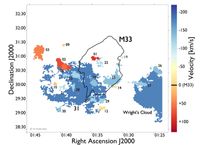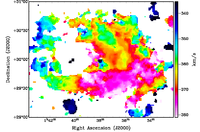Keenan's Ring
In some ways this is my favourite object of all. The other clouds tend to be small, piddly little things which are too far away for us to resolve properly. Keenan's Ring is also likely small on the grand scheme of things, but it's close : close enough we can resolve it in detail. And it's right next to M33, one of the most studied galaxies in the Universe, yet while it's as large on the sky as M33 itself, we only discovered it a few years ago ! Surely that should hammer-home the point that these kind of searches are important. Who knows what else we're missing at greater distances...
But I digress. The AGES survey of this region formed the basis of the PhD studies of Olivia Keenan. Earlier surveys had already found a bunch of clouds here. Olivia showed that some of these were actually just parts of the disc of M33 itself, and others which had appeared to be separate features became merged together in our higher-sensitivity data, but some were wholly new.
You can see immediately in the schematic that there are two giant blue blobs. Wright's Cloud has been known since the 1970s, but only small parts of cloud 31 – a.k.a. "Keenan's Ring" – were known from earlier surveys. It took the AGES data to show that these were part of this single, dramatic ring-shaped feature.
What exactly are all these clouds ? The exciting thing is... we don't know ! Earlier suggestions were that they represented debris as M33 interacts with M31, but the new clouds change the geometry of the population so that prospect seems less clear. Interestingly, the numbers and kinematic properties of the small clouds match the predictions from simulations as to how many satellite galaxies we should expect to detect in a region this size around a galaxy of this mass. And they're all optically dark.
But alas, this is likely just a weird coincidence. When you look in more detail, none of the clouds show signs of ordered motions, and their distribution on the sky doesn't match what you might expect for a population of satellite galaxies. And it's just too good to be true to suggest that in this one unique case, we can explain the missing satellite problem so neatly by finding that all its satellites are indeed dark galaxies. It doesn't – ahem – ring true.
My guess is that the smaller clouds are likely similar to the High Velocity Clouds we see around the Milky Way; circumgalactic material that might be a mixture of infalling primordial gas and debris left over from interactions. What of the two larger clouds ? Even weirder ! Especially Keenan's Ring. We know about polar rings that orbit around their parent galaxies, but rings which are offset both in space and velocity like this are extremely unusual – bordering on unique.
It doesn't help that Keenan's Ring and Wright's Cloud aren't terribly similar to each other. Wright's Cloud is comparable to, but significantly larger than, Keenan's Ring in terms of both mass and size. It's structurally and kinematically amorphous, whereas Keenan's Ring shows a clear velocity gradient across it. But not the sort of gradient we'd expect from a rotating (dark) galaxy. It's very confusing.
The main explanations for all these oddballs are dark galaxies, tidal debris, clouds in our own galaxy (we can't tell the distance accurately here), or part of the much larger Magellanic Stream. None of these explanations are convincing – but none can be definitively ruled out either.
You can find a more detailed analysis of this region on my blog here.

